For most of the long history of art, drawings and paintings have been concerned with
narrative, or telling a story. Because we are human, we naturally seek meaning in the circumstances of life, and therefore we relate strongly to pictures or images of the interactions of human figures. We read them like a text. Unlike a book that unfolds slowly, line by line, however, a drawing's impact, is immediate, visual, and sensuous.
Bernard Berenson, in studying the great Italian figure artists of the past, observed that we seem to project ourselves bodily into those constructed spaces. In viewing images, visual sensation becomes tactile. Ideas enter not just through the mind, but through the physical body.
The difference between drawing from the model in the classroom/studio and beginning to work with the problem of narrative is like the difference between composing a song and an opera. The artist must wrestle with multiple, interconnected layers of meaning, and organize the parts and their relationship to the greater whole through the visual means of expression.
The most obvious way that artists convey narrative is through the poses and gestures and situations of their models. But, as in good fiction writing or poetry, it's not enough to simply insert an action or a situation. Whether the drawing will be just an illustration of an idea, "telling" us what's going, or a powerful visual statement that "shows" us, depends ultimately on the artist's organization of the visual form. Art was never made by subject matter or content alone.
Henri Matisse had a few things to say about that:
"Expression, for me, is not a matter of the passion mirrored on the human face or revealed by a violent gesture. When I paint a picture, its every detail is expressive."
"The whole arrangement of my picture is expressive. The place occupied by the figures or objects, the empty spaces around them, the proportions, everything plays a part." -Henri Matisse
The problem of content or narrative does not negate the earlier and more fundamental concerns of figure drawing. Everything that is of concern to us in drawing from the model - gesture, proportion, construction, figure and ground, volume, mark, light and shadow, medium, the formal language - are still there and remain the fundamental problem in narrative figure work. Content has to be breathed into life through a visceral involvement with the making of FORM.
Following are some examples of the different Final Project Options. Old masters lead off followed by contrasts with contemporary artists who explore the issue of narrative in their work.
NARRATIVE IMAGERY
 |
| Caravaggio, David and Goliath |
\
 |
| Artemisia Gentilleschi - Judith and Holofernes |
 |
| Georges De La Tour - The Musicians' Argument |
 |
| Renoir - The Boating Party |
PERSONIFICATION
 |
| Bronzino - Cupid, Venus, Time & Folly |
 |
| Detail |
 |
| Bartolomeo Manfredi - The Four Seasons |
 |
| Eugene Delacroix - Liberty Leading the People |
 |
| Kathe Kollwitz - Uprising |
 |
| Prudhon - Justice and Vengeance Pursuing Crime |
 |
| Alfred Rethel- Nemesis | |
ALLEGORY or MYTH
 |
| Caravaggio - Narcissus |
 |
| Velazquez - Bacchus |
 |
| Titian - Diana and Actaeon |
 |
| Titian - Diana and Actaeon |
 | |
| Rubens - The Three Graces |
 |
| Ottaviani (Contemporary) - The Three Graces |
 |
| Rubens - The Judgment of Paris |
 |
| Jack Levine - The Judgment of Paris |
 |
| Jack Levine - The Judgment of Paris |
PROTEST
 |
| Gericault - The Raft of the Medusa |
 |
| Goya - The Third of May |
 |
| Kathe Kollwitz - Outbreak |
 |
| Kathe Kollwitz - Battlefield |
|
 |
| Kathe Kollwitz |
 |
| Carlton Fletcher |
NARRATIVE SPACES
 |
| Antonio Lopez Garcia |
 |
| Antonio Lopez Garcia |






















































